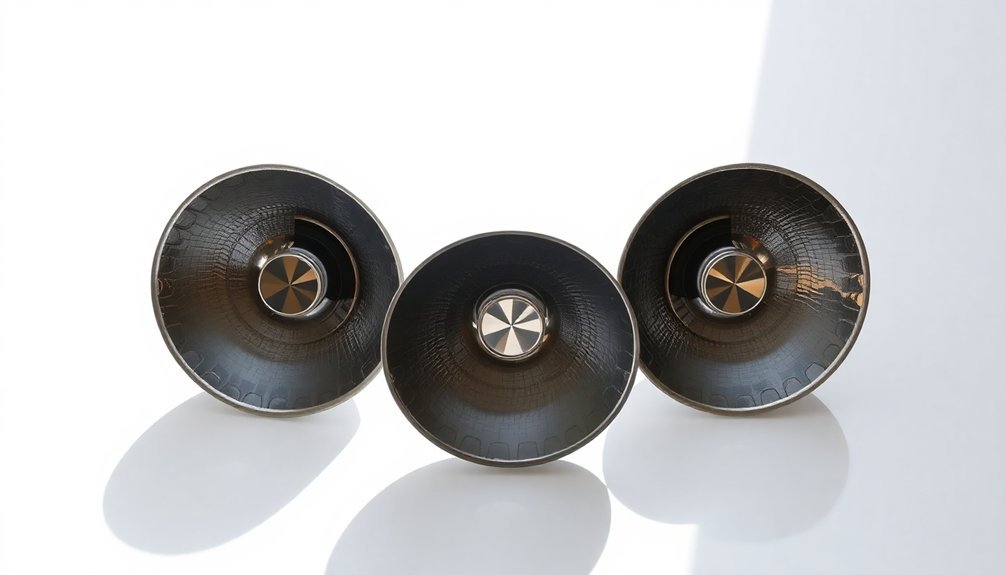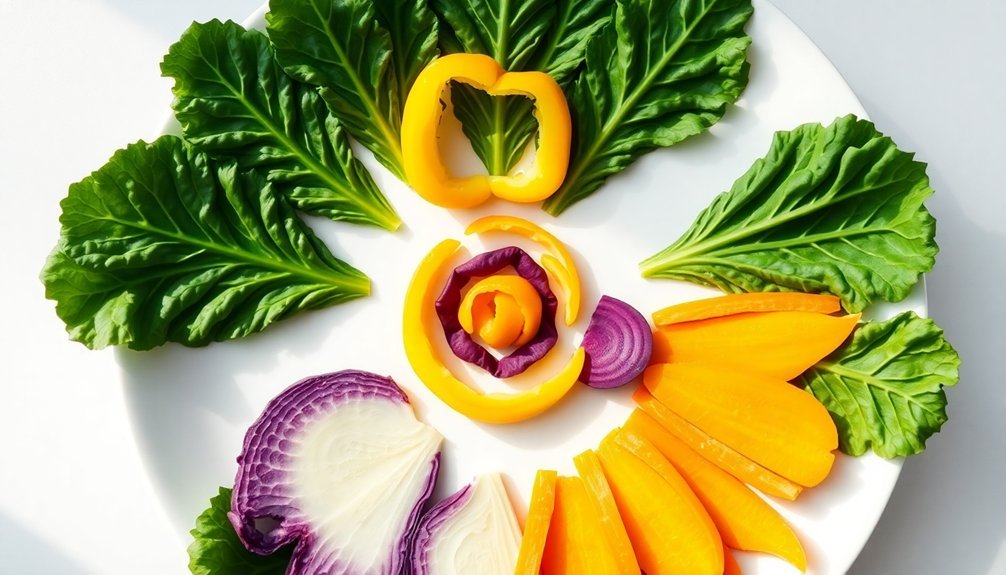If you're looking to maximize your outdoor cooking potential while staying eco-friendly, a dual-chamber solar oven might be your perfect solution. These innovative appliances have evolved considerably in 2025, offering enhanced efficiency and versatility that'll transform how you prepare meals off the grid. From compact portable models to advanced hybrid designs, we've tested and ranked the top 7 options to help you make an informed choice. Let's explore what makes these solar ovens stand out from the pack.
Solar Oven Portable Solar Cooker with Thermometer (4.5L)
Adventure seekers will appreciate the MrMapMax Solar Oven's blend of portability and power. This 13.85-pound cooker reaches temperatures up to 550°F and cooks meals in just 20 minutes using its 200-watt solar output.
You'll find the 4.5L capacity perfect for 2-3 people, while the vacuum tube chamber guarantees even cooking and moisture retention. The handbag-style design, complete with adjustable strap and zipper sides, makes transport effortless. It's versatile enough for camping, hiking, or emergency preparedness, and even works in cloudy conditions. Plus, it's safe enough for children to use unsupervised.
Best For: Outdoor enthusiasts, campers, and preparedness-minded individuals who want an eco-friendly, portable cooking solution that doesn't require fuel or electricity.
Pros:
- Impressive maximum temperature (550°F) and quick cooking time (20 minutes)
- Highly portable design with carrying strap and easy setup
- Works effectively even in cloudy conditions and maintains food moisture
Cons:
- Relatively heavy at 13.85 pounds compared to traditional camping stoves
- Limited capacity (4.5L) may not be sufficient for larger groups
- Some concerns about thermometer accuracy and container durability from user reviews
All Season Solar Cooker (17) Camper
The All Season Solar Cooker (17) Camper stands out as the ideal choice for outdoor enthusiasts who need versatile, year-round cooking power. This sunny yellow portable oven reaches 250 degrees and offers the largest cooking area of any solar cooker, fitting cookware up to turkey-roaster size.
You'll appreciate its coordinated articulating collector panels that maximize solar capture even in low sun conditions. At just 4 pounds and constructed from food-grade polypropylene, it's both durable and lightweight. When you're done cooking, it folds down to an inch thick for easy storage.
With 1.5 kilowatts of maximum energy output, you can prepare multiple meals daily, even during winter months.
Best For: Outdoor enthusiasts and campers who want a portable, eco-friendly cooking solution that works year-round and can handle large meals.
Pros:
- Large cooking capacity that accommodates multiple dishes and even turkey-sized cookware
- Lightweight and foldable design makes it highly portable and easy to store
- Versatile year-round performance with adjustable panels for optimal solar capture
Cons:
- Maximum temperature of 250 degrees is lower than some competing solar ovens
- Assembly instructions could be clearer for first-time users
- Larger size can make panel adjustments and positioning more challenging
GOSUN Fusion Solar Oven and Electric Hybrid Grill
Outdoor enthusiasts seeking a versatile cooking solution will find the GOSUN Fusion Solar Oven and Electric Hybrid Grill impressively efficient, cooking meals up to 5x faster than traditional electric ovens while consuming just 150 watts.
At just 16 pounds, you'll appreciate this portable grill's ability to reach 550°F in full sunlight, cooking most meals in about 20 minutes. The vacuum tube design maintains consistent heat, letting you bake, roast, steam, or sauté without monitoring. Whether you're camping off-grid or preparing for emergencies, you'll benefit from its dual power sources and included accessories like a carrying case and silicone molds.
Best For: Outdoor enthusiasts, campers, and eco-conscious consumers who want a portable, energy-efficient cooking solution that works both off-grid with solar power and with electrical backup.
Pros:
- Highly efficient hybrid cooking system using minimal power (150W) while achieving high temperatures
- Lightweight and portable design with included carrying case makes it perfect for outdoor activities
- Versatile cooking capabilities allowing for baking, roasting, steaming, and sautéing without monitoring
Cons:
- Some quality control issues reported with scratches and ill-fitting parts
- Cooking times can be lengthy (2-3 hours) without direct sunlight
- High price point compared to traditional portable grills or solar cookers
GOSUN Sport Solar Oven for Camping & Hiking
Portable and powerful, the GOSUN Sport Solar Oven proves ideal for three types of outdoor enthusiasts: campers seeking a lightweight cooking solution, hikers wanting reliable meal preparation, and preppers planning for emergencies.
You'll appreciate how this 8-pound solar stove deploys in seconds and reaches temperatures up to 550°F in full sunlight. The cooking tube's excellent insulation converts 80% of sunlight into usable heat while keeping the exterior cool. With its foldable parabolic reflectors and durable borosilicate glass construction, you can cook everything from hot dogs to brownies in as little as 20 minutes. You won't need fuel, and you'll get consistent results even when the sun isn't directly overhead.
Best For: Outdoor enthusiasts, particularly campers, hikers, and emergency preppers who want a lightweight, fuel-free cooking solution that harnesses solar power.
Pros:
- Reaches high temperatures (up to 550°F) quickly and cooks meals in as little as 20 minutes
- Completely safe and fuel-free operation with excellent heat retention and cool exterior
- Highly portable at 8 pounds with easy deployment and included cleaning tools
Cons:
- Dependent on sunlight availability and weather conditions for optimal performance
- Limited cooking capacity due to tube chamber size
- Higher initial cost compared to traditional portable camping stoves
Solar Stove Portable Solar Oven with 5L Capacity
Families seeking a versatile solar cooker will appreciate HIOSUNSTOVE's 5L capacity oven, which strikes an ideal balance between portability and cooking space. This 14-pound solar oven heats quickly, reaching 100°F in 10 minutes and 200°F in half an hour.
You'll find the aluminum and vacuum tube construction effective for cooking rice, meat, and baked goods, typically taking 1-1.5 hours in full sun. While the oven excels at unattended cooking during outdoor activities, you'll want to add a temperature probe for more precise results. Keep in mind that some users report durability concerns with the black straps, and you might need to source additional cooking accessories separately.
Best For: Outdoor enthusiasts and eco-conscious families who want a safe, portable cooking solution for camping, hiking, or backyard gatherings where traditional fuel sources aren't practical or desired.
Pros:
- Large 5L capacity makes it suitable for cooking group meals
- Quick heating capability, reaching cooking temperatures within 30 minutes
- Safe and flame-free operation, ideal for use around children and in fire-restricted areas
Cons:
- Durability issues reported with black straps
- Missing essential accessories like cookbook and replacement parts
- Cooking times can be lengthy and heavily dependent on weather conditions
Premium Solar Oven, Portable Outdoor Solar Cooker
The innovative Premium Solar Oven stands out as one of the most versatile choices for adventurous cooks who want to harness the sun's power. You'll reach temperatures up to 212°F, perfect for baking breads, cooking meats, or heating water.
The reinforced foam construction and reflective metal panels create efficient heat retention, while the transparent PVC lid lets you monitor your food. You'll appreciate the included support rods for stability and the spacious interior that fits a 5-quart Dutch oven.
For best results, elevate your cookware 1-2 inches off the reflector, use black pots with glass lids, and reposition the oven to follow the sun's path.
Best For: Outdoor enthusiasts, campers, and eco-conscious cooks looking for a portable, sustainable cooking solution that's ideal for emergency preparedness and off-grid living.
Pros:
- Highly portable and easy to store with spacious interior fitting a 5-quart Dutch oven
- Reaches cooking temperatures up to 212°F (100°C), suitable for various cooking methods
- Cost-effective and environmentally friendly with no fuel costs or emissions
Cons:
- Requires frequent repositioning to follow the sun and longer cooking times (1-6 hours)
- PVC cover can become unstable and sag onto cookware during use
- Weather-dependent performance and may be unstable in windy conditions
SAMSUNG Smart Double Wall Oven with Flex Duo (NV51K7770DG/AA)
Wait – I notice a discrepancy between the article title "Best Solar Ovens of 2025" and the product being discussed, which is an electric wall oven. The SAMSUNG NV51K7770DG/AA isn't a solar oven at all, but rather a high-end electric double wall oven that consumes 2,422 kilowatt hours annually.
While this smart oven boasts impressive features like Flex Duo technology, dual convection, and Wi-Fi connectivity, it doesn't belong in an article about solar ovens. The unit's built-in design, 273-pound weight, and requirement for electrical power make it fundamentally different from portable, environmentally-friendly solar cooking solutions. Let's return to discussing actual solar ovens that harness the sun's energy for cooking.
Best For: Luxury homeowners and tech-savvy cooks who want a premium built-in double wall oven with smart features and the flexibility to cook multiple dishes simultaneously at different temperatures.
Pros:
- Innovative Flex Duo technology allows for cooking two different dishes at different temperatures without flavor transfer
- Smart connectivity features enable remote monitoring and voice control through multiple platforms
- High-end features like dual convection and steam cooking ensure even, professional-quality results
Cons:
- High annual energy consumption at 2,422 kilowatt hours
- Premium price point may be prohibitive for many buyers
- Significant installation requirements due to built-in design and 273-pound weight
Factors to Consider When Choosing a Solar Oven With Dual Cooking Chambers
When choosing a dual-chamber solar oven, you'll need to evaluate essential factors like temperature ranges (typically 150-400°F) and whether both chambers can maintain consistent heat for different cooking needs. You should compare the dimensions of each chamber to guarantee they'll accommodate your typical meal portions while checking that the heat distribution system reaches all corners effectively. Consider how the oven's total weight and portability align with your usage plans, keeping in mind that dual chambers can extend cooking times by 20-30% compared to single-chamber models.
Temperature Control Range
Understanding temperature control range is vital when selecting a dual-chamber solar oven, since each cooking compartment needs consistent heat regulation for best results. You'll want to look for models that can reach up to 550°F in full sunlight while maintaining the flexibility to cook at lower temperatures around 250°F for baking and roasting.
Consider ovens with vacuum tube insulation, as they'll help maintain steady temperatures in both chambers. While higher-temperature settings can cook meals in just 20 minutes, you might need 1-1.5 hours for dishes requiring lower, sustained heat. Look for adjustable collector panels that optimize solar capture – they're important for maintaining consistent temperatures across both chambers, even in less-than-ideal sun conditions. This feature guarantees you can cook different dishes simultaneously without compromising either chamber's performance.
Chamber Size Comparison
Selecting the right chamber size in a dual-chamber solar oven can make or break your outdoor cooking experience. You'll want to evaluate total cooking capacity, which ranges from compact 4.5L models for small families to larger units that can handle a full turkey roaster.
When you're comparing chambers, look at how you'll use each space. If you're planning to cook different dishes simultaneously, you'll need chambers that offer separate temperature controls and adequate room for your cookware. Keep in mind that larger chambers provide more cooking flexibility but can impact portability. Check if the model folds down for easier transport and storage.
Don't overlook chamber materials and insulation quality – they'll affect how well your oven maintains cooking temperatures, especially during variable weather conditions.
Heat Distribution Efficiency
Effective heat distribution stands as a critical factor in dual-chamber solar ovens, directly impacting how evenly and efficiently your food will cook. You'll want to look for models with advanced heat-retention features like vacuum tubes or reflective surfaces that maintain consistent temperatures throughout both chambers.
When evaluating heat distribution efficiency, check the oven's maximum temperature capacity – the best models can reach up to 550°F. Consider how well the insulation prevents heat loss, as this affects cooking consistency across different dishes. You'll also need to verify proper positioning of your solar oven, as the angle and placement considerably influence heat distribution.
The dual-chamber design should allow you to cook different foods at varying temperatures without flavor transfer, making the most of available solar energy while maintaining ideal cooking conditions.
Portability and Weight
Three key mobility factors make dual-chamber solar ovens practical for outdoor cooking: weight, collapsibility, and ease of transport.
You'll want to focus on models weighing between 8 to 16 pounds, which provide an ideal balance between durability and portability. Ultralight options starting at 4 pounds are available if you're planning extensive hiking trips. Look for ovens that fold down to about an inch thick, as they'll take up minimal space in your gear.
Consider models equipped with carrying handles or shoulder straps, as these features make it easier to move your oven between cooking spots. Quick-assembly designs are essential – you don't want to spend precious outdoor time struggling with complicated setup procedures. The best portable solar ovens combine lightweight construction with user-friendly features that won't slow you down.
Cooking Time Requirements
Beyond your oven's portability features, understanding cooking time requirements will help you choose the right dual-chamber model for your needs. In ideal sunlight conditions, you'll find cooking times ranging from 20 minutes to 6 hours, depending on the model's efficiency and design.
Look for dual-chamber models that can reach temperatures up to 550°F, as they'll give you more cooking flexibility. These ovens let you simultaneously prepare different dishes at varying temperatures, saving valuable time. The sealed chambers help maintain moisture and guarantee even cooking, enhancing your food's flavor and tenderness.
Remember that weather considerably impacts performance. You'll need to account for longer cooking times during cloudy conditions, which can extend preparation by up to 1.5 hours for certain dishes.
Material Durability Analysis
When selecting a dual-chamber solar oven, material durability stands as a critical factor in your investment's longevity. You'll want to prioritize stainless steel components for their superior heat resistance and anti-corrosion properties, especially in the cooking chambers where temperature fluctuations are constant.
Look for models featuring vacuum tube insulation, as it'll protect the outer shell while maximizing heat retention. If you're considering portable options, food-grade virgin polypropylene offers an excellent balance of durability and lightweight convenience. Don't overlook weather resistance – your solar oven should include protective features against rain and UV damage.
Pay special attention to the reflective surfaces' quality, as they'll need to maintain their efficiency despite regular exposure to intense heat. High-grade reflective materials will guarantee consistent cooking performance throughout the oven's lifespan.
Energy Output Capacity
Understanding your solar oven's energy output capacity will directly impact your cooking efficiency and meal preparation options. The most powerful models deliver up to 1.5 kilowatts of energy, enabling you to cook larger portions in both chambers simultaneously.
You'll want to select an oven that reaches temperatures of up to 550°F (288°C), ensuring versatility in your cooking methods. Look for models with adjustable positioning features that maximize solar capture, especially during periods of limited sunlight. This adaptability helps maintain consistent energy output throughout the day.
Don't overlook insulation quality when evaluating energy capacity. Superior insulation directly affects heat retention and cooking speed. The better your oven maintains its target temperature, the more efficiently it'll convert solar energy into cooking power.
Setup and Storage Features
Three essential setup and storage features make dual-chamber solar ovens practical for outdoor cooking enthusiasts. You'll want to look for quick-setup mechanisms, particularly models with zipper designs or foldable components that let you assemble and disassemble your oven without hassle.
Consider the oven's portability features – lightweight construction, sturdy carrying handles, and comfortable straps make transport easier when you're heading to a campsite or beach. These elements prove vital for frequent outdoor cooks who need to move their ovens regularly.
Don't overlook storage efficiency. The best dual-chamber models fold down to compact sizes, fitting easily in limited storage spaces. Look for units with support rods that provide stability during cooking while maintaining a collapsible design for storage – you'll appreciate this dual functionality.
Frequently Asked Questions
Can Solar Ovens Work Effectively on Cloudy or Overcast Days?
While you'll still get some cooking power on cloudy days, your solar oven won't work as effectively. You'll experience longer cooking times and lower temperatures. It's best to use solar ovens during clear, sunny conditions.
What Happens if Food Is Left Too Long in a Solar Oven?
If you leave food too long in a solar oven, it'll dry out, become overcooked, or burn just like in regular ovens. You'll need to monitor cooking times carefully to prevent ruining your meal.
Are Solar Ovens Safe to Use Around Children?
You'll need to supervise children around solar ovens since they can get very hot. Keep kids at a safe distance, teach them about hot surfaces, and don't let them open the oven unsupervised.
How Do You Clean and Maintain Dual Chamber Solar Ovens?
You'll need to wipe down both chambers with warm, soapy water after each use. Don't forget to clean the reflectors, check seals regularly, and store your solar oven in a dry place when not in use.
Can You Cook Frozen Food Directly in Solar Ovens?
You can cook frozen food in solar ovens, but it's best to thaw it first. If you cook directly from frozen, you'll need considerably more time and should guarantee the food reaches safe cooking temperatures throughout.





Leave a Reply